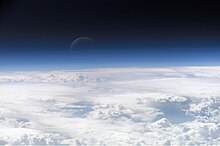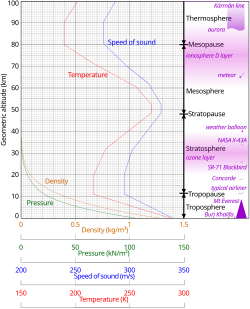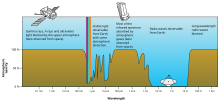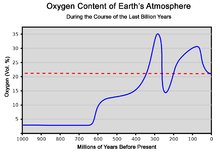This animation shows the buildup of tropospheric CO2 in the
Northern Hemisphere with a maximum around May. The maximum in the
vegetation cycle follows, occurring in the late summer. Following the
peak in vegetation, the drawdown of atmospheric CO2 due to photosynthesis is apparent, particularly over the Boreal Forests.

Blue light is scattered more than other wavelengths by the gases in the atmosphere, giving the Earth a blue halo when seen from space.

This image shows the moon
at centre, with the limb of Earth near the bottom transitioning into
the orange-coloured troposphere, the lowest and most dense portion of
the Earth's atmosphere. The troposphere ends abruptly at the tropopause,
which appears in the image as the sharp boundary between the orange-
and blue- coloured atmosphere. The silvery-blue noctilucent clouds extend far above the Earth's troposphere.
Atmospheric stratification describes the structure of the atmosphere, dividing it into distinct layers, each with specific characteristics such as temperature or composition. The atmosphere has a mass of about 5×1018 kg, three quarters of which is within about 11 km (6.8 mi; 36,000 ft) of the surface. The atmosphere becomes thinner and thinner with increasing altitude, with no definite boundary between the atmosphere and outer space. An altitude of 120 km (75 mi) is where atmospheric effects become noticeable during atmospheric reentry of spacecraft. The Kármán line, at 100 km (62 mi), also is often regarded as the boundary between atmosphere and outer space.
Air is the name given to atmosphere used in breathing and photosynthesis. Dry air contains roughly (by volume) 78.09% nitrogen, 20.95% oxygen, 0.93% argon, 0.039% carbon dioxide, and small amounts of other gases. Air also contains a variable amount of water vapor, on average around 1%. While air content and atmospheric pressure vary at different layers, air suitable for the survival of terrestrial plants and terrestrial animals is currently only known to be found in Earth's troposphere and artificial atmospheres.
Composition
Main article: Atmospheric chemistry
| ppmv: parts per million by volume (note: volume fraction is equal to mole fraction for ideal gas only, see volume (thermodynamics)) | |
| Gas | Volume |
|---|---|
| Nitrogen (N2) | 780,840 ppmv (78.084%) |
| Oxygen (O2) | 209,460 ppmv (20.946%) |
| Argon (Ar) | 9,340 ppmv (0.9340%) |
| Carbon dioxide (CO2) | 394.45 ppmv (0.039445%) |
| Neon (Ne) | 18.18 ppmv (0.001818%) |
| Helium (He) | 5.24 ppmv (0.000524%) |
| Methane (CH4) | 1.79 ppmv (0.000179%) |
| Krypton (Kr) | 1.14 ppmv (0.000114%) |
| Hydrogen (H2) | 0.55 ppmv (0.000055%) |
| Nitrous oxide (N2O) | 0.325 ppmv (0.0000325%) |
| Carbon monoxide (CO) | 0.1 ppmv (0.00001%) |
| Xenon (Xe) | 0.09 ppmv (9×10−6%) (0.000009%) |
| Ozone (O3) | 0.0 to 0.07 ppmv (0 to 7×10−6%) |
| Nitrogen dioxide (NO2) | 0.02 ppmv (2×10−6%) (0.000002%) |
| Iodine (I2) | 0.01 ppmv (1×10−6%) (0.000001%) |
| Ammonia (NH3) | trace |
| Not included in above dry atmosphere: | |
| Water vapor (H2O) | ~0.40% over full atmosphere, typically 1%-4% at surface |
Structure of the atmosphere
Principal layers
In general, air pressure and density decrease in the atmosphere as height increases. However, temperature has a more complicated profile with altitude. Because the general pattern of this profile is constant and recognizable through means such as balloon soundings, temperature provides a useful metric to distinguish between atmospheric layers. In this way, Earth's atmosphere can be divided into five main layers. From highest to lowest, these layers are:Exosphere
Main article: Exosphere
The outermost layer of Earth's atmosphere extends from the exobase
upward. It is mainly composed of hydrogen and helium. The particles are
so far apart that they can travel hundreds of kilometers without
colliding with one another. Since the particles rarely collide, the
atmosphere no longer behaves like a fluid. These free-moving particles
follow ballistic trajectories and may migrate into and out of the magnetosphere or the solar wind.Thermosphere
Main article: Thermosphere
Temperature increases with height in the thermosphere from the mesopause up to the thermopause,
then is constant with height. Unlike in the stratosphere, where the
inversion is caused by absorption of radiation by ozone, in the
thermosphere the inversion is a result of the extremely low density of
molecules. The temperature of this layer can rise to 1,500 °C (2,700 °F), though the gas molecules are so far apart that temperature in the usual sense is not well defined. The air is so rarefied that an individual molecule (of oxygen, for example) travels an average of 1 kilometer between collisions with other molecules.[3] The International Space Station
orbits in this layer, between 320 and 380 km (200 and 240 mi). Because
of the relative infrequency of molecular collisions, air above the
mesopause is poorly mixed compared to air below. While the composition
from the troposphere to the mesosphere is fairly constant, above a
certain point, air is poorly mixed and becomes compositionally
stratified. The point dividing these two regions is known as the turbopause.
The region below is the homosphere, and the region above is the
heterosphere. The top of the thermosphere is the bottom of the
exosphere, called the exobase. Its height varies with solar activity and ranges from about 350–800 km (220–500 mi; 1,100,000–2,600,000 ft).[citation needed]Mesosphere
Main article: Mesosphere
The mesosphere extends from the stratopause to 80–85 km (50–53 mi; 260,000–280,000 ft). It is the layer where most meteors burn up upon entering the atmosphere. Temperature decreases with height in the mesosphere. The mesopause,
the temperature minimum that marks the top of the mesosphere, is the
coldest place on Earth and has an average temperature around −85 °C (−120 °F; 190 K).[4] At the mesopause, temperatures may drop to −100 °C (−150 °F; 170 K).[5] Due to the cold temperature of the mesosphere, water vapor is frozen, forming ice clouds (or Noctilucent clouds). A type of lightning referred to as either sprites or ELVES, form many miles above thunderclouds in the troposphere.Stratosphere
Main article: Stratosphere
The stratosphere extends from the tropopause to about 51 km (32 mi;
170,000 ft). Temperature increases with height due to increased
absorption of ultraviolet radiation by the ozone layer, which restricts turbulence and mixing. While the temperature may be −60 °C (−76 °F; 210 K) at the tropopause, the top of the stratosphere is much warmer, and may be near freezing[citation needed]. The stratopause,
which is the boundary between the stratosphere and mesosphere,
typically is at 50 to 55 km (31 to 34 mi; 160,000 to 180,000 ft). The
pressure here is 1/1000 sea level.Troposphere
Main article: Troposphere
The troposphere begins at the surface and extends to between 9 km (30,000 ft) at the poles and 17 km (56,000 ft) at the equator,[6]
with some variation due to weather. The troposphere is mostly heated by
transfer of energy from the surface, so on average the lowest part of
the troposphere is warmest and temperature decreases with altitude. This
promotes vertical mixing (hence the origin of its name in the Greek
word "τροπή", trope, meaning turn or overturn). The troposphere contains roughly 80% of the mass of the atmosphere.[7] The tropopause is the boundary between the troposphere and stratosphere.Other layers
Within the five principal layers determined by temperature are several layers determined by other properties:- The ozone layer is contained within the stratosphere. In this layer ozone concentrations are about 2 to 8 parts per million, which is much higher than in the lower atmosphere but still very small compared to the main components of the atmosphere. It is mainly located in the lower portion of the stratosphere from about 15–35 km (9.3–22 mi; 49,000–110,000 ft), though the thickness varies seasonally and geographically. About 90% of the ozone in our atmosphere is contained in the stratosphere.
- The ionosphere, the part of the atmosphere that is ionized by solar radiation, stretches from 50 to 1,000 km (31 to 620 mi; 160,000 to 3,300,000 ft) and typically overlaps both the exosphere and the thermosphere. It forms the inner edge of the magnetosphere. It has practical importance because it influences, for example, radio propagation on the Earth. It is responsible for auroras.
- The homosphere and heterosphere are defined by whether the atmospheric gases are well mixed. In the homosphere the chemical composition of the atmosphere does not depend on molecular weight because the gases are mixed by turbulence.[8] The homosphere includes the troposphere, stratosphere, and mesosphere. Above the turbopause at about 100 km (62 mi; 330,000 ft) (essentially corresponding to the mesopause), the composition varies with altitude. This is because the distance that particles can move without colliding with one another is large compared with the size of motions that cause mixing. This allows the gases to stratify by molecular weight, with the heavier ones such as oxygen and nitrogen present only near the bottom of the heterosphere. The upper part of the heterosphere is composed almost completely of hydrogen, the lightest element.
- The planetary boundary layer is the part of the troposphere that is nearest the Earth's surface and is directly affected by it, mainly through turbulent diffusion. During the day the planetary boundary layer usually is well-mixed, while at night it becomes stably stratified with weak or intermittent mixing. The depth of the planetary boundary layer ranges from as little as about 100 m on clear, calm nights to 3000 m or more during the afternoon in dry regions.
Physical properties

Comparison of the 1962 US Standard Atmosphere graph of geometric altitude against air density, pressure, the speed of sound and temperature with approximate altitudes of various objects.[14]
Pressure and thickness
Main article: Atmospheric pressure
The average atmospheric pressure at sea level
is about 1 atmosphere (atm)=101.3 kPa (kilopascals)=14.7 psi (pounds
per square inch)=760 torr=29.92 inches of mercury (symbol Hg). Total
atmospheric mass is 5.1480×1018 kg (1.135×1019 lb),[15]
about 2.5% less than would be inferred from the average sea level
pressure and the Earth's area of 51007.2 megahectares, this portion
being displaced by the Earth's mountainous terrain. Atmospheric pressure
is the total weight of the air above unit area at the point where the
pressure is measured. Thus air pressure varies with location and weather.If the atmosphere had a uniform density, it would terminate abruptly at an altitude of 8.50 km (27,900 ft). It actually decreases exponentially with altitude, dropping by half every 5.6 km (18,000 ft) or by a factor of 1/e every 7.64 km (25,100 ft), the average scale height of the atmosphere below 70 km (43 mi; 230,000 ft). However, the atmosphere is more accurately modeled with a customized equation for each layer that takes gradients of temperature, molecular composition, solar radiation and gravity into account.
In summary, the mass of the earth's atmosphere is distributed approximately as follows:[16]
- 50% is below 5.6 km (18,000 ft).
- 90% is below 16 km (52,000 ft).
- 99.99997% is below 100 km (62 mi; 330,000 ft), the Kármán line. By international convention, this marks the beginning of space where human travelers are considered astronauts.
Even above the Kármán line, significant atmospheric effects such as auroras still occur. Meteors begin to glow in this region though the larger ones may not burn up until they penetrate more deeply. The various layers of the earth's ionosphere, important to HF radio propagation, begin below 100 km and extend beyond 500 km. By comparison, the International Space Station and Space Shuttle typically orbit at 350–400 km, within the F-layer of the ionosphere where they encounter enough atmospheric drag to require reboosts every few months. Depending on solar activity, satellites can still experience noticeable atmospheric drag at altitudes as high as 700–800 km.
Density and mass

Temperature and mass density against altitude from the NRLMSISE-00 standard atmosphere model (the eight dotted lines in each "decade" are at the eight cubes 8, 27, 64, ..., 729)
Main article: Density of air
The density of air at sea level is about 1.2 kg/m3 (1.2
g/L). Density is not measured directly but is calculated from
measurements of temperature, pressure and humidity using the equation of
state for air (a form of the ideal gas law). Atmospheric density decreases as the altitude increases. This variation can be approximately modeled using the barometric formula. More sophisticated models are used to predict orbital decay of satellites.The average mass of the atmosphere is about 5 quadrillion (5×1015) tonnes or 1/1,200,000 the mass of Earth. According to the American National Center for Atmospheric Research, "The total mean mass of the atmosphere is 5.1480×1018 kg with an annual range due to water vapor of 1.2 or 1.5×1015 kg depending on whether surface pressure or water vapor data are used; somewhat smaller than the previous estimate. The mean mass of water vapor is estimated as 1.27×1016 kg and the dry air mass as 5.1352 ±0.0003×1018 kg."
Optical properties
See also: Sunlight
Solar radiation (or sunlight) is the energy the Earth receives from the Sun.
The Earth also emits radiation back into space, but at longer
wavelengths that we cannot see. Part of the incoming and emitted
radiation is absorbed or reflected by the atmosphere.Scattering
Main article: Scattering
When light passes through our atmosphere, photons interact with it through scattering. If the light does not interact with the atmosphere, it is called direct radiation and is what you see if you were to look directly at the Sun. Indirect radiation is light that has been scattered in the atmosphere. For example, on an overcast
day when you cannot see your shadow there is no direct radiation
reaching you, it has all been scattered. As another example, due to a
phenomenon called Rayleigh scattering,
shorter (blue) wavelengths scatter more easily than longer (red)
wavelengths. This is why the sky looks blue; you are seeing scattered
blue light. This is also why sunsets
are red. Because the Sun is close to the horizon, the Sun's rays pass
through more atmosphere than normal to reach your eye. Much of the blue
light has been scattered out, leaving the red light in a sunset.Absorption
Main article: Absorption (electromagnetic radiation)
Different molecules absorb different wavelengths of radiation. For example, O2 and O3 absorb almost all wavelengths shorter than 300 nanometers. Water (H2O)
absorbs many wavelengths above 700 nm. When a molecule absorbs a
photon, it increases the energy of the molecule. We can think of this as
heating the atmosphere, but the atmosphere also cools by emitting
radiation, as discussed below.
Rough plot of Earth's atmospheric transmittance (or opacity) to various wavelengths of electromagnetic radiation, including visible light.
Emission
Main article: Emission (electromagnetic radiation)
Emission is the opposite of absorption, it is when an object
emits radiation. Objects tend to emit amounts and wavelengths of
radiation depending on their "black body"
emission curves, therefore hotter objects tend to emit more radiation,
with shorter wavelengths. Colder objects emit less radiation, with
longer wavelengths. For example, the Sun is approximately 6,000 K (5,730 °C; 10,340 °F), its radiation peaks near 500 nm, and is visible to the human eye. The Earth is approximately 290 K (17 °C; 62 °F), so its radiation peaks near 10,000 nm, and is much too long to be visible to humans.Because of its temperature, the atmosphere emits infrared radiation. For example, on clear nights the Earth's surface cools down faster than on cloudy nights. This is because clouds (H2O) are strong absorbers and emitters of infrared radiation. This is also why it becomes colder at night at higher elevations. The atmosphere acts as a "blanket" to limit the amount of radiation the Earth loses into space.
The greenhouse effect is directly related to this absorption and emission (or "blanket") effect. Some chemicals in the atmosphere absorb and emit infrared radiation, but do not interact with sunlight in the visible spectrum. Common examples of these chemicals are CO2 and H2O. If there are too much of these greenhouse gases, sunlight heats the Earth's surface, but the gases block the infrared radiation from exiting back to space. This imbalance causes the Earth to warm, and thus climate change.
Refractive index
The refractive index of air is close to, but just greater than 1. Systematic variations in refractive index can lead to the bending of light rays over long optical paths. One example is that, under some circumstances, observers onboard ships can see other vessels just over the horizon because light is refracted in the same direction as the curvature of the Earth's surface.The refractive index of air depends on temperature, giving rise to refraction effects when the temperature gradient is large. An example of such effects is the mirage.
See also: Scintillation (astronomy)
Circulation
Main article: Atmospheric circulation
Atmospheric circulation is the large-scale movement of air through the troposphere, and the means (with ocean circulation) by which heat
is distributed around the Earth. The large-scale structure of the
atmospheric circulation varies from year to year, but the basic
structure remains fairly constant as it is determined by the Earth's
rotation rate and the difference in solar radiation between the equator
and poles.Evolution of Earth's atmosphere
See also: History of Earth and Paleoclimatology
Earliest atmosphere
The first atmosphere would have consisted of gases in the solar nebula, primarily hydrogen. In addition there would probably have been simple hydrides such as are now found in gas-giant planets like Jupiter and Saturn, notably water vapor, methane and ammonia. As the solar nebula dissipated these gases would have escaped, partly driven off by the solar wind.[17]Second atmosphere
The next atmosphere, consisting largely of nitrogen plus carbon dioxide and inert gases, was produced by outgassing from volcanism, supplemented by gases produced during the late heavy bombardment of Earth by huge asteroids.[17] A major rainfall led to the buildup of a vast ocean. A major part of carbon dioxide exhalations were soon dissolved in water and built up carbonate sediments.Water-related sediments have been found dating from as early as 3.8 billion years ago.[18] About 3.4 billion years ago, nitrogen was the major part of the then stable "second atmosphere". An influence of life has to be taken into account rather soon in the history of the atmosphere, since hints of early life forms are to be found as early as 3.5 billion years ago.[19] The fact that this is not perfectly in line with the 30% lower solar radiance (compared to today) of the early Sun has been described as the "faint young Sun paradox".
The geological record however shows a continually relatively warm surface during the complete early temperature record of the Earth with the exception of one cold glacial phase about 2.4 billion years ago. In the late Archaean eon an oxygen-containing atmosphere began to develop, apparently from photosynthesizing algae which have been found as stromatolite fossils from 2.7 billion years ago. The early basic carbon isotopy (isotope ratio proportions) is very much in line with what is found today,[20] suggesting that the fundamental features of the carbon cycle were established as early as 4 billion years ago.
Third atmosphere

Oxygen content of the atmosphere over the last billion years. This diagram in more detail
The amount of oxygen in the atmosphere has gone up and down during the last 600 million years. There was a peak 280 million years ago, when the amount of oxygen was about 30 %, much higher than today. Two main processes govern changes in the atmosphere: Plants converts carbon dioxide into the bodies of the plants, which emits oxygen into the atmosphere, and break down of pyrite rocks cause sulphur to be added to the oceans. Volcanos cause this sulphur to be oxidized, reducing the amount of oxygen in the atmosphere. But volcanos also emit carbon dioxide, so that plants can convert this to oxygen. The exact cause of the variation of oxygen in the atmosphere is not known. Periods with much oxygen in the atmosphere are believed to cause rapid development of animals. Even if the atmosphere today has only 21 percent oxygen, today is still regarded as a period with rapid development of animals because of a high amount of oxygen in the atmosphere.[23]
Currently, anthropogenic greenhouse gases are increasing in the atmosphere. According to the Intergovernmental Panel on Climate Change, this increase is the main cause of global warming.[24]
Air pollution
Main article: Air pollution
Air pollution is the introduction of chemicals, particulate matter, or biological materials that cause harm or discomfort to organisms into the atmosphere.[25] Stratospheric ozone depletion is believed to be caused by air pollution (chiefly from chlorofluorocarbons).





No comments:
Post a Comment